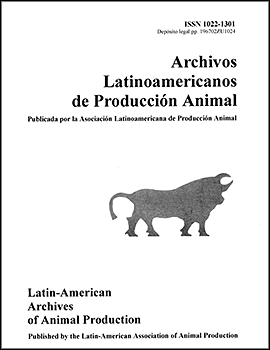
|
Archivos Latinoamericanos de Produccion Animal
Asociacion Latinoamericana de Produccion Animal
ISSN: 1022-1301
EISSN: 1022-1301
Vol. 14, No. 2, 2006, pp. 62-64
|
 Bioline Code: la06010
Bioline Code: la06010
Full paper language: English
Document type: Research Article
Document available free of charge
|
|
|
Archivos Latinoamericanos de Produccion Animal, Vol. 14, No. 2, 2006, pp. 62-64
| en |
Effect of proteolysis index on texture of dry-cured ham
J. Ruiz-Ramírez, X. Serra, P. Gou, J. Arnau
Abstract
The objective of this study was to determine the effect of proteolysis index on the relationship between water content and hardness in the interior of dry-cured hams. To obtain different degrees of proteolysis 18 hams from two pH groups (high: 6.2 to 6.8 and low: 5.5 to 5.7) and three added NaCl levels (2, 5 and 8%) were used. The pH was measured in semimembranosus muscle at 24 h postmortem (pHSM24). The biceps femoris muscle was excised from dry-cured hams at the end of the process. Thereafter nine samples were shaped into parallelepipeds of 4×2×2 cm and dried to different levels of moisture content covering the range from 30.6 to 58.2%. The rest of the muscle was ground and vacuum packed until its subsequent physicochemical analysis. At the end of drying period, a Texture Profile analysis was carried out to determine textural parameters of the samples. The hardness of biceps femoris muscle of dry-cured hams diminished when the IP was increased. The cohesiveness diminished with decreasing proteolysis index. The differences in cohesiveness by effect of proteolysis index were more important at high moisture contents similar to those existing inside of dry-cured ham during ageing. The reduction of added NaCl level in the production of dry-cured ham, especially in hams with low pHSM24, causes a higher proteolysis index in the final product. Dry-cured hams samples with higher proteolysis index present lower hardness and higher cohesiveness, and can be associated with an unwanted pasty and / or soft texture.
Keywords
Dry-cured ham, water content, NaCl content, pH, proteolysis index, hardness.
|
| |
| es |
Efecto del índice de proteolisis sobre la textura del jamón crudo curado
J. Ruiz-Ramírez, X. Serra, P. Gou, J. Arnau
Resumen
El objetivo de este estudio fue determinar el efecto del índice de proteolisis sobre la relación entre el contenido de agua y la dureza en el interior de jamones crudos curados. Para obtener diferentes grados de proteolisis se utilizaron 18 perniles con 2 niveles de pH (alto: de 6,2 hasta 6,8 y bajo: de 5,5 hasta 5,7) y tres niveles de NaCl añadido (2, 5 y 8%). El pH fue medido en el músculo semimembranosus (SM) a las 24 h postmortem (pHSM24). Del músculo bíceps femoris de cada jamón crudo curado se obtuvieron 9 trozos de 4x2x2 cm. Los trozos fueron secados hasta alcanzar niveles de secado desde 30,6% hasta 58,2% de humedad. El resto del músculo fue picado y envasado al vacío hasta su posterior análisis fisicoquímico. Al final del periodo de secado, se realizó un perfil de textura instrumental sobre las muestras secadas. La dureza del músculo bíceps femoris de jamones crudos curados disminuyó cuando el índice de proteolisis se incrementó. La cohesividad disminuyó cuando disminuyó el índice de proteolisis, siendo las diferencias en cohesividad por efecto del índice de proteolisis fueron más importantes a valores más altos de humedad que son los que existen en el interior del jamón curado durante el procesado. La reducción del nivel de NaCl añadido en la elaboración del jamón crudo curado, especialmente en perniles con pHSM24 bajo, provoca un mayor índice de proteolisis en el producto final. Las muestras de jamones crudos curados con mayor índice de proteolisis presentan menor dureza y mayor cohesividad y puede asociarse a una textura blanda y/o pastosa indeseable.
Palabras-clave
jamón crudo curado, contenido de agua, contenido de NaCl, pH, índice de proteolisis, dureza.
|
| |
© Copyright 2006 - ALPA. Arch. Latinoam. Prod. Anim.
Alternative site location: http://www.alpa.org.ve/ojs/index.php
|
|
